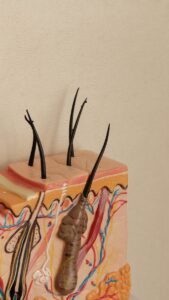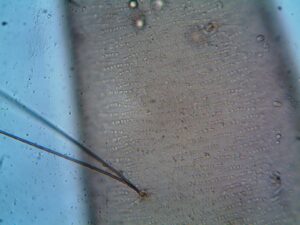Hair Growth Cycle: Key Stages and Hair Health Tips
The hair growth cycle is a fascinating and complex process that plays a crucial role in the health of our hair. Understanding the different stages of hair growth can help in promoting better hair care practices and addressing issues such as hair loss. This article will explore the four stages of the hair growth cycle, their significance, and tips for maintaining optimal hair health.
The Hair Growth Cycle: An Overview

Photo by Roselène de Koning on Pexels
The hair growth cycle consists of four distinct stages: anagen, catagen, telogen, and exogen. Each phase represents a different point in the life of a strand of hair, and together, they dictate the overall health and appearance of your hair. The cycle begins with the anagen phase, where actively growing hair is produced by the hair follicle. This is followed by the catagen phase, which is a transitional stage, then the telogen phase, where the hair rests before eventually shedding. Understanding this cycle is essential for anyone looking to enhance their hair care routine.
Understanding the Four Stages of Hair Growth
The four stages of the hair growth cycle are integral to a healthy head of hair. During the anagen phase, hair grows actively, with the hair bulb playing a critical role in the elongation of the hair shaft. This phase can last for several years, depending on individual genetics. The catagen phase is a short transitional period where hair growth slows down and the hair follicle undergoes changes. Following this, the telogen phase, or resting phase, can last for a few months, during which hair may shed naturally. Finally, the exogen phase involves the shedding of old hair, making way for new hair growth. Each stage is essential in maintaining a balanced hair cycle.
The Role of the Hair Growth Cycle in Hair Health
The hair growth cycle directly impacts hair health, influencing factors such as hair density and texture. A balanced cycle promotes the growth of terminal hair, which is thicker and healthier than vellus hair. Disruptions in this cycle can lead to conditions like telogen effluvium, a temporary loss of hair often triggered by stress or hormonal changes. Understanding how each phase of the hair cycle affects overall hair health can aid in implementing effective hair care strategies to combat issues like hair fall and patchy hair loss.
Factors Influencing the Hair Growth Cycle
Several factors can influence the hair growth cycle, including genetics, hormones, and environmental conditions. Insulin-like growth factor and other growth factors are crucial for the supply to the hair follicles, helping to sustain the anagen growth phase. Additionally, lifestyle choices such as diet and stress management play significant roles in maintaining a healthy hair cycle. By recognizing and addressing these factors, individuals can take proactive steps to enhance the growth of their hair, reduce the loss of hair, and promote overall hair health.
Detailed Examination of Each Stage of the Hair Growth Cycle
The Anagen Phase: Active Growth
The anagen phase is the first and most crucial stage in the hair growth cycle, characterized by actively growing hair. During this phase, which can last several years, the hair follicle produces the hair shaft, resulting in significant elongation of the hair. The hair bulb at the base of the follicle plays a vital role in the growth of the hair strand, supported by essential growth factors, including insulin-like growth factor. This phase is critical for achieving a healthy head of hair, as it determines the thickness and length of the hair. Hair growth may vary among individuals based on genetic factors, but actively growing hair is essential for maintaining hair density.
The Catagen Phase: Transitioning Stage
The catagen phase serves as a transitional stage where hair growth significantly slows down. During this phase, which lasts only a few weeks, the hair follicle undergoes changes, and the hair strand detaches from the blood supply. This results in the formation of club hair, which is a key indicator that the hair is no longer in the growth phase. While this phase is relatively brief, it is essential for preparing the hair for the subsequent telogen phase, allowing the scalp hair to transition smoothly into its resting state. Understanding this transitional stage helps in recognizing the natural ebb and flow of hair growth and the mechanisms behind hair loss.
The Telogen Phase: Resting Phase Explained
The telogen phase, also known as the resting phase, is the third stage in the hair growth cycle and can last several months. During this time, the hair follicle is inactive, and hair may remain in the scalp without further growth. Telogen hair, which is shed naturally, is often replaced by new hair as the cycle renews. This phase is crucial for the overall health of the hair, allowing the scalp to rest and rejuvenate. However, stress or hormonal changes can disrupt this natural process, leading to conditions such as telogen effluvium, which can cause hair fall and patchy hair loss. Understanding the telogen phase is vital for addressing hair health concerns.
Impacts of Telogen Effluvium on Hair Health

Photo by Kelcey Shotit on Pexels
Causes and Symptoms of Telogen Effluvium
Telogen effluvium is a temporary condition that results in hair loss, primarily affecting the telogen phase of the hair growth cycle. Various factors can cause hair loss, including stress, hormonal fluctuations, and certain medical conditions. Symptoms often manifest as excessive shedding of hair during daily activities, such as washing or brushing. Individuals may notice a noticeable thinning of hair density, leading to concerns about their overall hair health. Recognizing the causes of telogen effluvium is crucial for effective management and restoration of hair growth, allowing individuals to take proactive steps in their hair care routine.
Diagnosing Telogen Effluvium
Diagnosing telogen effluvium involves a careful assessment of the individual’s hair growth cycle and any recent changes that may have triggered hair loss. Healthcare professionals typically evaluate the history of hair loss, potential stressors, and any hormonal imbalances that might be impacting hair health. A physical examination of the scalp hair can also provide insights into the phase at any given time. In some cases, a scalp biopsy may be necessary to determine the specific type of hair loss. Accurate diagnosis is essential for distinguishing telogen effluvium from other forms of hair loss, ensuring appropriate treatment strategies are employed for optimal hair recovery.
Managing Telogen Effluvium Effectively
Effectively managing telogen effluvium requires a multifaceted approach that addresses both the underlying causes and the symptoms of hair loss. Individuals should focus on stress management techniques, such as mindfulness and relaxation exercises, to mitigate triggers. Additionally, a balanced diet rich in essential nutrients can aid in supporting the hair growth cycle. Incorporating specific hair care products that promote scalp health and stimulate hair follicles can also be beneficial. In more severe cases, consulting a dermatologist or trichologist may provide targeted therapies that enhance the growth of new hair and restore hair density, ultimately improving overall hair health.
Hair Care Tips for Healthy Hair Growth

Photo by Darina Belonogova on Pexels
Essential Hair Care Practices
To promote healthy hair growth, it is vital to adopt essential hair care practices. Regular washing with a gentle shampoo can help maintain scalp health, while conditioning treatments nourish the hair shaft, preventing dryness and breakage. Incorporating a balanced routine that includes scalp massages can stimulate blood flow to the hair follicles, enhancing the supply of growth factors. Additionally, using heat protectants before styling can minimize damage, preserving the integrity of actively growing hair.
Importance of Nutrition for Hair Health
Nutrition plays a critical role in supporting hair health and growth. A diet rich in vitamins and minerals, particularly those like biotin, zinc, and iron, contributes to the strength of hair strands. Consuming protein is especially important, as hair is primarily made of keratin, a protein that requires adequate supply for the production of new hair. Healthy fats, such as omega-3 fatty acids, also promote scalp health, ensuring that hair follicles receive the nourishment they need for optimal growth.
Common Mistakes to Avoid in Hair Care
Avoiding common mistakes in hair care is essential for maintaining healthy locks. One prevalent error is over-washing, which can strip natural oils and lead to dryness. Additionally, using harsh chemicals in hair products can cause damage, making the hair more susceptible to breakage and loss. Failing to protect hair from environmental stressors, such as UV rays and pollution, can also hinder the growth cycle and result in thinning hair. Being mindful of these pitfalls can help cultivate a thriving mane.
Exploring Treatments for Hair Loss

Photo by Isabella Mendes on Pexels
Understanding Hair Transplants
Hair transplants are a popular solution for those experiencing significant hair loss. This surgical procedure involves transferring hair follicles from a donor area, typically the back of the scalp, to areas where hair is thinning or balding. By focusing on the anagen growth phase, the transplanted hair follicles can continue to grow, producing healthy, terminal hair. Understanding the procedure’s intricacies and potential for permanent hair loss solutions is vital for individuals considering this option to restore their hair density.
Non-Surgical Options for Hair Restoration
For individuals hesitant about surgical interventions, non-surgical options for hair restoration are available. Treatments such as platelet-rich plasma (PRP) therapy utilize growth factors derived from the patient’s own blood to stimulate hair follicles and promote new hair growth. Other alternatives include topical minoxidil, which encourages blood supply to the hair follicles, and laser therapy, which can enhance hair density by improving scalp health. These methods provide valuable solutions for those seeking to address hair loss without invasive procedures.
Future Trends in Hair Loss Treatment
The future of hair loss treatment is promising, with ongoing research leading to innovative therapies. Advances in regenerative medicine, such as stem cell therapy, hold the potential to revolutionize hair restoration, targeting the hair growth cycle at its core. Additionally, the development of personalized medicine approaches, which consider individual genetics and specific causes of hair loss, is gaining traction. These trends indicate a shift towards more effective, tailored solutions for hair health and growth, enhancing the overall quality of life for individuals facing hair loss challenges.
What is the hair growth cycle and why is it important?
The hair growth cycle is a fascinating process that involves four key stages: the anagen phase (growth phase), the catagen phase (transitional phase), the telogen phase (resting phase), and the shedding of new hair. Understanding this cycle is crucial for anyone interested in maintaining healthy hair and preventing hair loss. Each phase has its own unique characteristics and duration, affecting how your hair grows and maintains itself. By knowing the cycle, you can better tailor your hair care regimen to promote healthy hair growth.
What happens in the anagen phase?
The anagen phase is the active growth phase of the hair growth cycle and can last for several years, depending on factors such as genetics and overall health. During this time, the hair follicle is continuously producing a hair shaft that elongates and emerges from the scalp. This is when your hair is made strong and resilient. To support the anagen phase, focus on nourishing your body with vitamins and minerals that act as growth factors, which can enhance the production of growing hair.
What is the purpose of the catagen phase?
The catagen phase is a transitional stage that lasts for a few weeks, during which the hair follicle undergoes significant changes. This phase marks the end of active growth, and the hair follicle shrinks, pushing the hair shaft upward. Although it may seem concerning, this phase is necessary for the regeneration of hair and the preparation for the next cycle. Embracing this transition can help you appreciate the natural rhythms of your hair growth.
How does the telogen phase affect hair health?
The telogen phase, also known as the resting phase, is a crucial part of the hair growth cycle. Lasting about 3 to 4 months, this phase allows your hair follicles to rest before they begin producing new hair again. During the telogen phase, the hair strand is fully formed but is not actively growing. At the end of this phase, the old hair will eventually shed, making way for new hair to enter the anagen phase, which is the active growth phase of the hair cycle.
It’s important to note that not all hair follicles are in the same phase at the same time; they cycle through the phases independently. This staggered cycle helps maintain a full head of hair, as only a portion of the hair is in the telogen phase at any given moment. Factors such as stress, hormonal changes, nutritional deficiencies, and certain medical conditions can disrupt this cycle, potentially leading to increased hair shedding or thinning.
Understanding the hair growth cycle, including the telogen phase, can be beneficial for managing hair health and addressing hair loss concerns. Proper care and attention during all phases of hair growth can help promote a healthy environment for hair to thrive.


